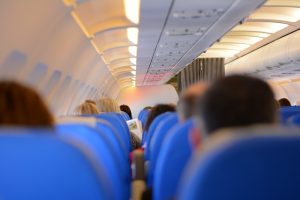
Ever wonder why the cabin air inside of a typical commercial jet is so dry? Some commercial jets have a relative humidity level of 20%, whereas others have a relative humidity level of just 5%. To put those numbers into perspective, the relative humidity level inside of a typical home is about 40% to 60%.
Relative humidity is a measurement of moisture vapor in the air. It’s known as “relative humidity” because it takes into account the temperature of the air. Relative humidity represents the amount of moisture vapor in the air relative to the total amount of moisture vapor that the air can hold at its current temperature. A relative humidity level of 20% means the air is holding 20% of the moisture vapor that it can hold at its current temperature.
Bleed Air
The main reason airplanes have such dry cabin air is because they use “bleed air.” They pull air from the engines, which they use to fill and pressurize the cabins. Bleed air is naturally dry. It contains very little moisture content, resulting in a low relative humidity level.
Commercial jets are powered by jet engines. During flight, the jet engines will burn a combination of jet fuel — typically a special type of kerosene — along with air. Before entering the combustion chamber, some of this air will be bled off. It will pass through a compressor, at which point the air will be redirected to the cabin.
Airplanes have dry cabin air because the air at high altitudes is dry. This is the same air that they use for combustion within their jet engines. As an airplane’s altitude increases, it will be exposed to dry air. This dry air will be bled off for use in the airplane’s cabin.
Corrosion Protection
Some professionals in the aviation industry have proposed the use of humidification systems for cabins. After all, there are humidification systems for homes and buildings, so conventional wisdom should lead you to believe that they will work for airplane cabins as well. Humidification systems consist of devices that release moisture vapor into the air, thereby increasing the relative humidity level of the surrounding space.
The problem with humidification systems for airplanes is that they promote corrosion. Humidity and corrosion go hand in hand. When metal parts are exposed to moisture, including airborne moisture vapor, they may corrode. Therefore, most airplanes intentionally use dry air for their cabins.



